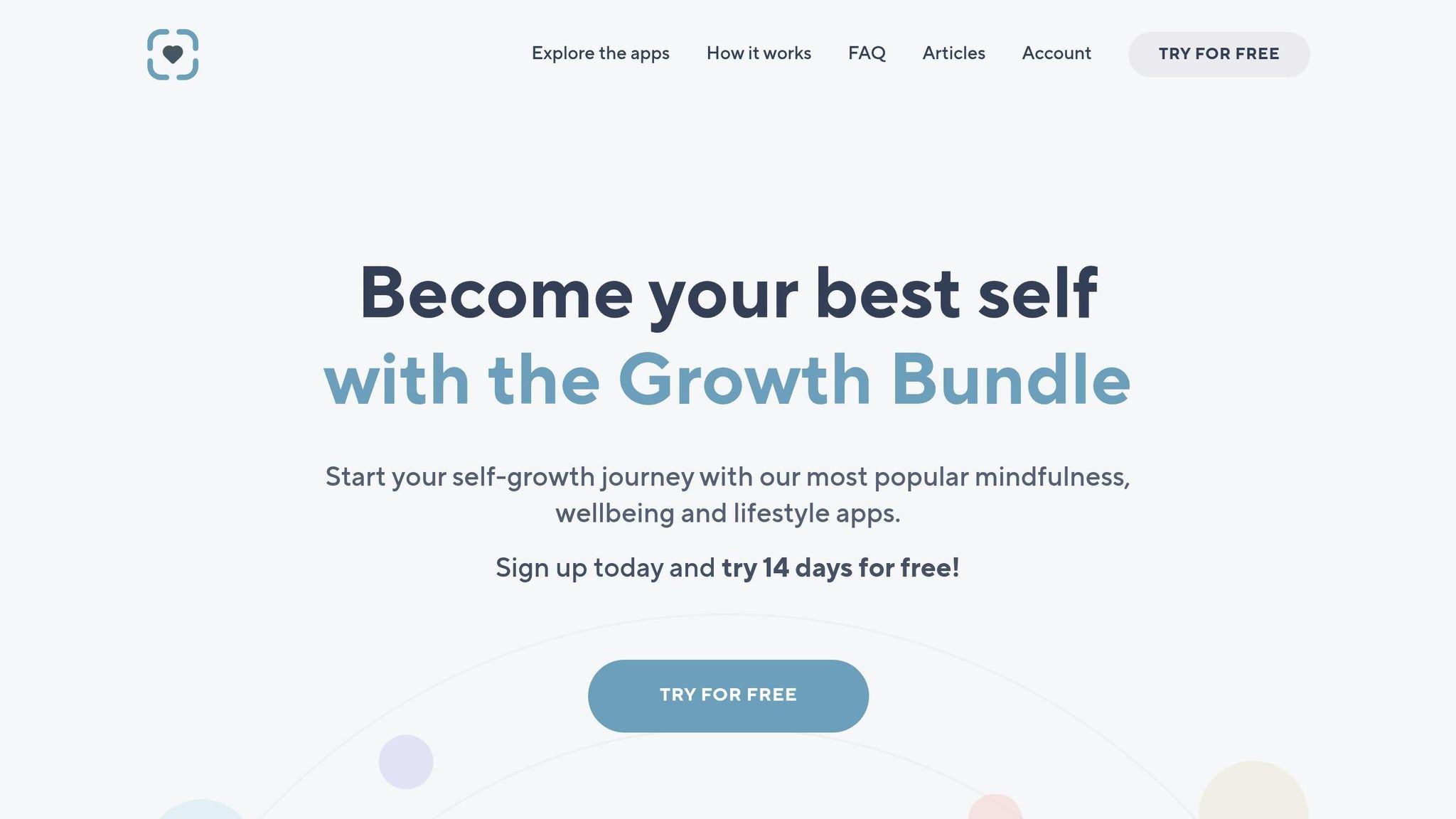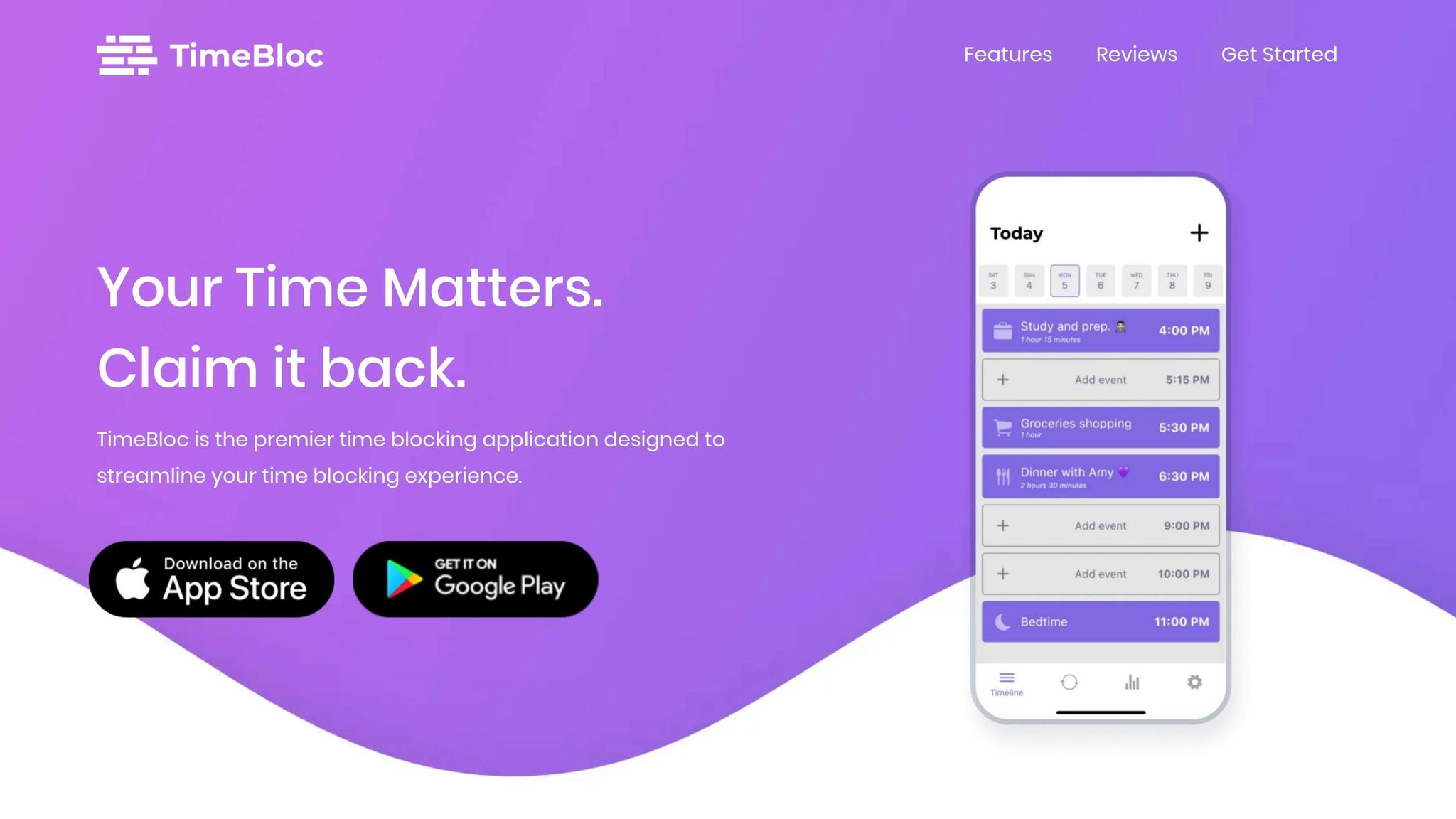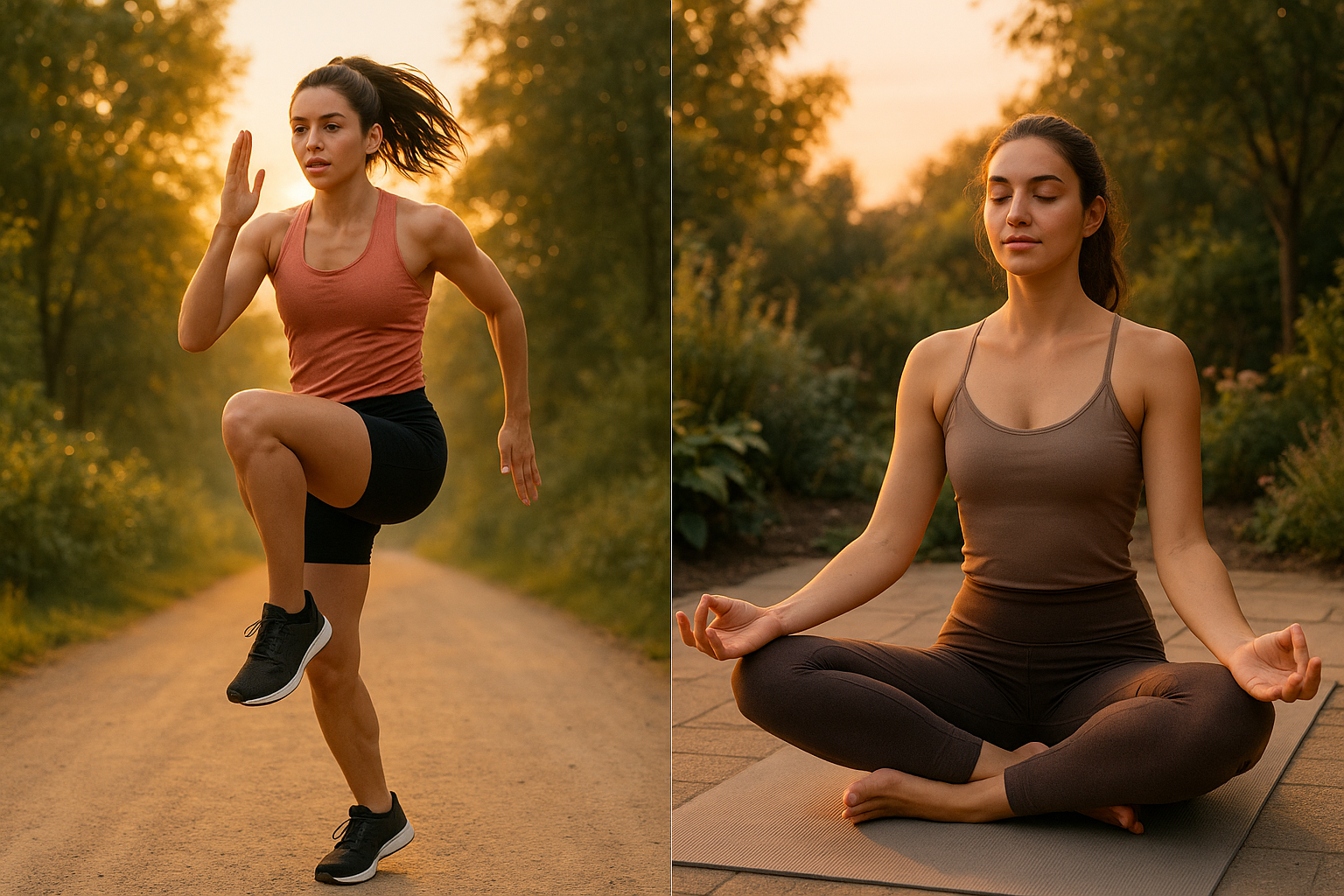Looking for a simple, effective daily fitness routine? Pairing a quick morning HIIT session with a relaxing evening yoga practice could be your answer. This combination supports energy, recovery, and overall health by syncing with your body’s natural rhythms.
Here’s why this works:
- Morning HIIT: Boosts metabolism, burns fat, and enhances brain function in just 15–20 minutes.
- Evening Yoga: Reduces stress, improves sleep, and aids recovery with gentle stretches and mindfulness.
This balanced approach combines exertion and relaxation, making it ideal for long-term health. Keep reading for a step-by-step guide to structuring your day with these two practices.
The Benefits of Morning HIIT and Evening Yoga
Why Morning HIIT Works
Starting your day with high-intensity interval training (HIIT) can set the tone for an energetic and productive day. After a night of fasting, your body is primed to burn fat more efficiently during intense exercise, as glycogen stores are naturally lower in the morning.
One of the standout benefits of morning HIIT is the afterburn effect, officially known as Excess Post-Exercise Oxygen Consumption (EPOC). This means your metabolism stays elevated for hours after your workout, helping you burn more calories even while at rest. Plus, morning HIIT aligns with your body’s natural hormonal rhythms, giving you an extra edge in reaching your fitness goals.
Beyond the physical perks, morning HIIT floods your system with endorphins and boosts brain-derived neurotrophic factor (BDNF), which supports brain health and keeps your energy levels steady throughout the day.
Some great exercises to include in your morning HIIT routine are burpees, mountain climbers, jump squats, and high knees. These compound movements target multiple muscle groups, making your workout efficient and effective. For a quick yet powerful session, try a Tabata protocol - 20 seconds of intense effort followed by 10 seconds of rest, repeated for four minutes.
Now, let’s see how evening yoga complements this dynamic start.
The Restorative Power of Evening Yoga
Yoga in the evening is like hitting the reset button for your body and mind. By activating the parasympathetic nervous system, it promotes relaxation, aids digestion, and supports recovery from the day’s stresses.
Studies suggest that practicing yoga in the evening can help lower cortisol levels, which may lead to better sleep, a stronger immune system, and reduced inflammation. Stretching during yoga also improves flexibility and joint mobility, easing the stiffness that often builds up from sitting or standing for long periods.
Breathing techniques like pranayama play a key role in calming the nervous system. They help lower your heart rate and blood pressure, guiding your body into a state of deep relaxation.
Certain poses are particularly effective in the evening. For instance, Child’s Pose, Legs-Up-The-Wall, and Supine Spinal Twist release tension in areas commonly affected by daily activities. Beyond the physical benefits, yoga’s mindfulness aspect can reduce anxiety and improve sleep patterns, contributing to mental clarity and overall well-being.
Together, these practices create a balanced approach to daily health.
How Morning HIIT and Evening Yoga Work Together
Pairing morning HIIT with evening yoga creates a perfect synergy for your body. HIIT provides a controlled stressor that builds strength and endurance, while yoga offers the restorative balance needed for recovery and repair.
This combination also supports a healthy sleep-wake cycle by balancing hormone levels and regulating stress. HIIT energizes you for the day ahead, while yoga helps you wind down and prepare for restful sleep. Together, they create an internal environment that promotes cellular repair and long-term health.
Incorporating both high-intensity and restorative exercises into your routine can also improve consistency. The variety keeps workouts engaging and reduces the risk of overuse injuries. A quick morning HIIT session jumpstarts your day, while an evening yoga practice helps you transition into rest, ensuring better sleep and improved performance the next day.
This balanced routine is a sustainable way to support your fitness and overall well-being for the long haul.
10 min Yoga Warm-Up - Pre-Workout & Morning Yoga
How to Structure Your Morning HIIT + Evening Yoga Routine
This plan is designed to energize your mornings and help you unwind in the evenings, creating a balanced approach to fitness and recovery.
Morning HIIT: Energize Your Day
Start your morning with a quick 15–20 minute HIIT workout to wake up your body and ignite your metabolism.
Warm-Up (2–3 minutes):
Begin with light cardio and dynamic stretches like jogging in place, arm circles, and leg swings. This prepares your muscles and reduces the risk of injury.
Core Workout:
Alternate 30 seconds of intense effort with 15 seconds of rest. Aim for 4–6 rounds based on your fitness level. Here’s a sample routine you can tweak to suit your needs:
- Exercise Pair 1: 30 seconds of burpees, 15 seconds of rest, then 30 seconds of jump squats followed by another 15 seconds of rest. Repeat for several rounds.
- Exercise Pair 2: 30 seconds of mountain climbers, 15 seconds of rest, then 30 seconds of high knees with another 15-second rest.
- Exercise Pair 3: 30 seconds of push-ups, 15 seconds of rest, then 30 seconds of jumping jacks with a final 15-second rest.
To increase resistance, incorporate 5–10 lb dumbbells or a 15–35 lb kettlebell for moves like kettlebell swings. This adds intensity, building strength while burning extra calories.
Cool-Down (2 minutes):
Wrap up with a gentle cool-down - walk in place and stretch lightly to lower your heart rate gradually.
This efficient workout gives you a powerful start to the day and sets the tone for your evening recovery.
Evening Yoga: Unwind and Restore
Your evening yoga session is all about relaxation and recovery. Dedicate 20–30 minutes to this calming practice, ideally 1–2 hours before bed.
Set the Mood:
Dim the lights, play soft instrumental music, and keep the room at a comfortable temperature (68–72°F). A light aroma from lavender or chamomile essential oils can enhance the soothing atmosphere.
Breathing Practice (5 minutes):
Ease into relaxation with deep breathing. Try the 4-7-8 technique: inhale for 4 counts, hold for 7 counts, and exhale for 8 counts. This signals your body to wind down.
Flow Through Poses:
Move smoothly from one pose to the next, holding each for longer than you would in a morning routine. Focus on releasing tension rather than building strength. A sample sequence might include:
- Cat-Cow stretches (2 minutes) to release spinal tension.
- Child’s Pose (3–4 minutes) for gentle relaxation.
- Supine Spinal Twist (2 minutes per side) to ease tightness.
- Happy Baby Pose (3 minutes) to open up the hips.
- Legs-Up-The-Wall (5–8 minutes) to calm the nervous system.
Finish with Savasana (Corpse Pose) for at least 5 minutes, allowing your body to absorb the benefits of the session. Throughout, maintain slow, deep breathing, letting your exhales last longer than your inhales.
Safety and Scheduling Tips
Balancing intensity in the morning with recovery at night is key to making this routine sustainable.
- Hydration: Drink 16–20 oz of water when you wake up, sip 4–6 oz during your HIIT session, and avoid drinking too much right before yoga to prevent discomfort.
- Listen to Your Body: If you feel stiff in the morning, ease into movements and avoid pushing through pain. During HIIT, reduce intensity or extend rest periods if you feel dizzy or nauseous. In yoga, move gently into poses without forcing your body.
Fitting It Into Your Day:
Mornings can be tight - waking up 25–30 minutes earlier might help. If mornings don’t work, consider a quick HIIT session during lunch, though you may miss out on the benefits of fasted training.
For evenings, consistency matters more than perfection. Even a 10–15 minute yoga session can be effective. Focus on restorative poses like Child’s Pose, Legs-Up-The-Wall, and gentle twists if you're short on time.
Adjust as Needed:
During stressful periods, you might dial down the intensity of HIIT and spend more time on yoga. If you’re feeling fatigued or struggling with sleep, tweak the timing, intensity, or environment of your routine. Let your body guide your adjustments instead of sticking rigidly to a plan.
With these steps, you can seamlessly integrate this energizing and restorative routine into your lifestyle.
sbb-itb-72d195f
Using Growth Bundle Apps to Optimize Your Routine

The right apps can turn your morning HIIT sessions and evening yoga into habits that stick. Growth Bundle offers a suite of wellness apps that work together to help you plan, track, and reflect on your progress. This makes it easier to stay committed to your exercise routine for the long haul.
Here’s how specific apps can simplify scheduling, tracking, and recovery.
Plan and Schedule with Timebloc

Timebloc is a handy tool for organizing your day, making it effortless to set aside time for both your morning HIIT and evening yoga. With its drag-and-drop feature, you can block out specific times - like 7:00–7:30 AM for HIIT or 8:00–8:30 PM for yoga - directly into your schedule.
The app’s color-coded system allows you to assign unique colors to your workout blocks, helping them stand out from meetings or other commitments. Plus, you can set recurring reminders that give you a heads-up before each session, ensuring you’re ready to dive in.
One standout feature is the ability to add custom notes to each time block. For example, you can jot down “burpees + jump squats” for Monday’s HIIT or “hip openers + spinal twists” for your evening yoga. This eliminates any guesswork and keeps you focused. Studies even show that using digital planners to schedule workouts can boost adherence by up to 40%. Unsurprisingly, Timebloc enjoys a 4.7/5 rating on the App Store, making it a favorite among users.
Track Progress with Do App and HealthView

When it comes to tracking your progress, Do App and HealthView make a great pair. The Do App helps you log your workouts and maintain a streak, which can be highly motivating. Meanwhile, HealthView syncs with Apple Health to track metrics like heart rate, calories burned, and workout intensity, giving you a clearer picture of your performance.
HealthView goes a step further by monitoring physiological markers like heart rate variability (HRV) and resting heart rate. These insights can guide adjustments to your routine. For instance, if your resting heart rate is elevated or HRV is lower than usual, it might be time to ease up on your HIIT sessions or add more restorative yoga poses. Research backs this up - tracking progress with apps can lead to a 25% increase in achieving fitness goals.
Reflect and Recover with Reflectly and The Mindfulness App

The mental and emotional aspects of fitness are just as important as the physical ones, and that’s where Reflectly and The Mindfulness App come in. Reflectly helps you log how you feel before and after workouts, track your mood, and note patterns. For example, you might discover that morning HIIT energizes you for the day or that evening yoga sets the stage for better sleep. With over 30,000 users giving it a 4.8/5 rating, Reflectly is a trusted tool for building emotional resilience and mental clarity.
On the recovery side, The Mindfulness App offers guided meditations and breathing exercises tailored for post-workout relaxation. Spending 10–15 minutes meditating after yoga can deepen your recovery, reduce cortisol levels, and activate your parasympathetic nervous system - the “rest and digest” mode essential for cellular repair. Reflective practices like journaling with Reflectly have been linked to a 23% drop in stress and a 17% improvement in mood.
Building a Long-Term Longevity Routine
Once you've established a daily rhythm, the next step is creating a routine that promotes long-term health and wellness. This isn't about quick fixes - it's about consistency and finding what works for you. A mix of morning HIIT workouts and evening yoga can provide a well-rounded approach, improving cardiovascular health, building strength, enhancing flexibility, and managing stress - key pillars for living well over time.
Tips for Maintaining Longevity and Wellbeing
- Start small and grow gradually: Begin with short sessions - 10 to 15 minutes for each activity - and increase the duration as your body adjusts. This gradual approach minimizes the risk of burnout and injury.
- Listen to your body: Adjust the intensity of your workouts based on how you're feeling that day. Tools like Reflectly can help you track your energy and mood, giving you insights to fine-tune your routine.
- Consistency over intensity: Regular, moderate exercise is more effective than occasional high-intensity bursts. Apps like the Growth Bundle's Done habit tracker can help you stay on track by visually rewarding your streaks.
- Prioritize recovery: Recovery is just as important as the workouts themselves. Evening yoga serves as active recovery, but don't skip full rest days - they're essential for long-term progress.
Taking the First Step
Kick things off tomorrow with a simple 10-minute HIIT session. Start with exercises like jumping jacks, bodyweight squats, and mountain climbers, alternating 30 seconds of activity with 30 seconds of rest. Repeat the circuit twice. In the evening, dedicate 15 minutes to yoga, focusing on poses that open the hips and gently stretch the spine. To enhance your recovery, consider adding a 5–10 minute meditation session using The Mindfulness App after your yoga practice. And for extra support, download the Growth Bundle apps to help you stay consistent and motivated as you build your routine.
FAQs
How does combining morning HIIT and evening yoga support long-term health and longevity?
Pairing a morning HIIT workout with evening yoga offers a balanced approach to fitness that benefits both your body and mind. HIIT ramps up your cardiovascular health, builds muscle strength, and keeps your metabolism active, while yoga focuses on improving flexibility, easing stress, and aiding recovery.
This blend of high-energy exercise and calming, restorative movement works wonders for reducing chronic pain, sharpening mental focus, and supporting healthy aging. Together, they form a routine that's not just effective but also sustainable, promoting overall well-being in the long run.
What are some beginner-friendly exercises for a morning HIIT and evening yoga routine?
For those just starting out, kick off your morning HIIT routine with low-impact exercises like brisk walking, modified burpees, or jumping jacks. A quick 10-minute session might look like this: alternate 30 seconds of light jogging with 30 seconds of rest, repeating the cycle for several rounds. These moves are beginner-friendly but still pack a punch when it comes to getting your heart rate up.
In the evening, shift gears and focus on calming yoga poses such as Child’s Pose, Cat-Cow, Mountain Pose, and Reclining Twist. These stretches are great for easing muscle tension, boosting flexibility, and clearing your mind - perfect for winding down after a busy day. Choose poses that feel good for your body and slowly expand your practice as you grow more comfortable.
How do Growth Bundle apps help you stick to a daily fitness routine with morning HIIT and evening yoga?
Growth Bundle apps simplify sticking to your fitness routine by offering personalized workout plans, progress tracking, and motivating reminders. Whether you're into HIIT sessions or yoga flows, these apps adapt to your fitness level, recovery needs, and busy schedule.
With these tools, fitting in a morning HIIT workout and an evening yoga session becomes effortless. They’re designed to help you stay consistent, boosting your physical health, sharpening your mind, and improving your overall well-being.
